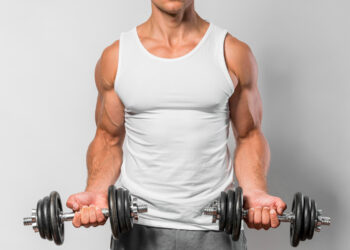Shoulder pain is a common problem for exercisers and non-exercisers alike (1). The shoulder is a very mobile but unstable joint, making it prone to aches, pains, and injuries. The conventional barbell bench press can be particularly tough on your shoulders and is a common source of discomfort.
As a veteran personal trainer, lifetime exerciser, and former powerlifter, I’ve dealt with more than my fair share of shoulder problems. Some have come on suddenly, i.e., acute injuries, while others were chronic and developed over time. I’ve also helped many clients overcome their shoulder pain.
Needless to say, some injuries require medical attention and rest to heal, so always seek professional advice rather than ignore pain. However, if your symptoms are mild and you’ve been told it’s okay to do so, you may be able to modify your workout to make it more joint-friendly.
In this article, I share my top ten chest exercises for lifters with beat-up shoulders.
Top Ten Shoulder-Friendly Chest Exercises
Painful shoulders are no joke, but they don’t have to stop you from training. Here are my top ten shoulder-friendly exercises.
1. Barbell Floor Press
The barbell floor press is an old-school chest exercise that predates the bench press by hundreds of years. Training your chest on the floor reduces your range of motion, taking stress off your shoulders. This is also an excellent exercise for home workouts.
Level Up Your Fitness: Join our 💪 strong community in Fitness Volt Newsletter. Get daily inspiration, expert-backed workouts, nutrition tips, the latest in strength sports, and the support you need to reach your goals. Subscribe for free!
Steps:
- Place a barbell in a squat rack set to about hip height.
- Lie on the floor with your eyes beneath the bar. Keep your legs straight or bent as you prefer.
- Grip the bar with an overhand, slightly wider than shoulder-width grip. Press your upper back into the floor.
- Unrack the bar, bend your elbows, and lower the weight until your upper arms lightly touch the floor. Tuck your elbows slightly inward as you descend.
- Extend your arms and drive the bar back up. Continue for the desired number of reps.
- Carefully re-rack the bar and rest.
Tips:
- Do this exercise with a spotter or in a power rack for safety.
- Experiment with your grip width to determine what’s most comfortable and effective.
- Lift your hips to turn this into more of a decline press:
2. Single-Arm Dumbbell Floor Press
While I love the barbell floor press and include it in many of my shoulder-friendly chest workouts, I have a soft spot for this single-arm dumbbell variation. Training one arm at a time makes it easier to identify and fix left-to-right strength imbalances, and using a dumbbell is usually easier for home and solo workouts.
Steps:
- Lie on the floor with your legs bent or straight as preferred.
- Hold a single dumbbell over your chest with a neutral or pronated grip.
- Press your shoulders into the floor and brace your core.
- Bend your arm and lower the weight until your upper arm lightly touches the floor.
- Tuck your elbow into your side slightly as you descend.
- Press the dumbbell back up and repeat.
- Switch arms and do the same number of reps on the other side.
Tips:
- Use your non-training arm for assistance/self-spotting if necessary.
- You can also do this exercise with two dumbbells.
- No dumbbells? Use kettlebells instead.
3. Dumbbell Floor Fly
Dumbbell flies are a popular and effective way to isolate your chest. However, doing them on a bench means it’s all too easy to hyperextend your shoulders, creating potentially harmful joint stress. Doing dumbbell flyes on the floor minimizes this bottom-end stretch, taking stress off your shoulders.
Steps:
- Lie on the floor with your legs bent or straight as preferred.
- Hold a dumbbell in each hand using a neutral grip. Raise and hold the weights over your chest. Keep your elbows slightly bent but rigid.
- Open your arms and lower the dumbbells to the side to form a T-shape. Allow your upper arms to touch the floor lightly.
- Squeeze the dumbbells back up and together, and then repeat.
Tips:
- Go light, as this exercise is more challenging than it looks.
- Rest your head on a folded exercise mat or foam pad for comfort.
- This exercise is ideal for supersetting with dumbbell floor presses. Do one set of floor flyes immediately fooled by floor presses.
4. Dumbbell Incline Squeeze Press
The dumbbell incline squeeze press is a very accessible, shoulder-friendly chest exercise. The incline angle and close grip make this a comfortable exercise and an excellent alternative to horizontal presses. It also produces an intense pec contraction, making it a superb chest builder.
Steps:
- Set your bench to a 10 to 20-degree incline. Sit on the bench with a dumbbell in each hand.
- Using a neutral grip, press the weights together and lie back so the dumbbells are on the center of your chest and your upper arms are close to your sides.
- Drive the weights up while keeping them presses together.
- Lower the dumbbells back to your chest and repeat.
Tips:
- This exercise works best with hex-shaped dumbbells, as they’re easier to keep together.
- Press the dumbbells inward and upward to maximize tension in your pecs.
- Avoid doing steep angle presses, i.e., above 30 degrees, as they may increase shoulder stress.
5. Barbell Pin Press
The mid-point of the bench press is where your shoulders are under the most stress. In this position, your joints are extended, which stretches the muscles and connective tissue. Consequently, reducing the range of motion will help limit shoulder stress. One way to do this is to lower the bar to the pins in a power rack and not your chest.
Steps:
- Set the safety bars on your power rack so they’re 8-12 inches above your chest.
- Set up for bench presses as usual, and unrack the bar.
- Bend your arms and lower the bar to lightly touch the safety rack.
- Pause without relaxing for 2-3 seconds.
- Drive the bar back up and repeat.
Tips:
- Make sure both sides of the barbell touch down at the same time.
- The further the safety bars are from your chest, the more shoulder-friendly this exercise becomes.
- Adjust the width of your hands to reflect your needs and goals. A shoulder-width or slightly wider grip is usually more shoulder-friendly than a wide grip.
6. Barbell Board Bench Press
Board presses are used by powerlifters to increase lockout strength. Despite this, they’re also an excellent exercise for regular lifters with beat-up shoulders. The board press limits your range of motion, protecting your shoulders from hyperextension. All you need for this exercise is a yoga block or similar.
Steps:
- Lie on your bench and place a yoga block on your chest where the bar normally touches down.
- Set up for the bench press as usual and then unrack the bar.
- Bend your arms and lower the bar to touch the block lightly.
- Drive the weight back up and repeat.
Tips:
- Do this exercise with a spotter or in a power rack for safety.
- Use two blocks if you want to reduce your range of motion even further.
- Fix the block on your chest with a resistance band if necessary.
7. Slingshot Bench Press
A slingshot is a resistance band for bench pressing. Invented by powerlifter Mark Bell, this band wraps around your upper arms to provide assistance out of the bottom of your bench press rep. As you know, this is the most joint-stressful part of the bench press, and help in this position will reduce harmful joint stress.
Steps:
- Place your slingshot band around your upper arms.
- Set up for bench presses as usual, and unrack the bar.
- Bend your arms and lower the bar to lightly touch your chest.
- Pause without relaxing for 2-3 seconds.
- Drive the bar back up and repeat.
Tips:
Level Up Your Fitness: Join our 💪 strong community in Fitness Volt Newsletter. Get daily inspiration, expert-backed workouts, nutrition tips, the latest in strength sports, and the support you need to reach your goals. Subscribe for free!
- No slingshot? Use a strong booty band instead.
- Experiment with your grip width to determine what’s most comfortable and effective.
- You can also use a slingshot band for incline and decline bench presses, as well as push-ups.
8. Band-Assisted Bench Press
Most lifters use bands to make their workouts more challenging. However, you can also use them to reduce the weight at the bottom of your bench press for a more shoulder-friendly workout. You’ll need two bands and a power rack for this exercise.
Steps:
- Attach two bands to the top of your power rack and then loop them around your barbell. Rack and load the bar with the required weight.
- Set up for bench presses as usual, and unrack the bar.
- Bend your arms and lower the bar to lightly touch your chest.
- Pause without relaxing for 2-3 seconds.
- Drive the bar back up and repeat.
Tips:
- Check your bands before use, as a broken band could cause severe injury.
- You can also use this set-up for incline and decline bench presses.
- Reduce the strength of the bands as your shoulder pain diminishes, eventually returning to non-assisted bench presses when you are pain-free.
9. Spoto Bench Press
The Spoto press was invented by powerlifter Eric Spoto. Competitive lifters use this exercise to increase lockout strength, but it’s also an effective shoulder-saver. The best thing about this shoulder-friendly chest exercise is that it doesn’t require any additional equipment, so no bands, blocks, or slingshot. As such, it’s as accessible as it is effective.
Steps:
- Set up for bench presses as usual, and unrack the bar.
- Bend your arms and lower the bar to about 6 to 8 inches above your chest.
- Pause without relaxing for 2-3 seconds.
- Drive the bar back up and repeat.
Tips:
- Don’t go too heavy too soon; this exercise is surprisingly challenging.
- Do Spoto presses in a power rack or with a spotter for safety.
- Experiment with your grip width to determine what’s most comfortable and effective.
10. Block Push-Up
Push-ups are one of the best chest exercises around, albeit one that many people only do when they don’t have access to weights. This simple modification makes push-ups even more shoulder-friendly than they already are. This exercise is perfect for home workouts and as a finisher after lifting weights.
Steps:
- Place a yoga block on the floor.
- Squat down and place your hands shoulder-width apart on either side of the block.
- Walk your feet out and back into the push-up position.
- Brace your core and tense your legs.
- Bend your arms and lower your chest to lightly touch the block.
- Extend your arms and repeat as required.
Tips:
- Stack two blocks together to further reduce your range of motion.
- Use weight plates or any other prop available to limit your range of motion.
- Adjust your hand position for comfort. A shoulder-width placement is usually more joint-friendly than wide hands.
Learn more about how to avoid shoulder pain here.
FAQ’s
Do you have a question about joint-friendly chest training? No problem, because I’ve got the answers. Alternatively, drop me a line in the comments section below if you need more information, and I’ll get back to you as soon as possible.
1. Is it safe to train around shoulder pain?
While it’s often safe to train around shoulder pain, other times, it’s not. It all depends on the cause and severity of whatever is bothering you.
If your pain is sharp, severe, or came on suddenly, you may have an acute injury that needs treatment and rest. Other warning signs are swelling, redness, and loss of strength. However, dull aches and stiffness that decrease as you warm up are usually less serious.
All that said, if in doubt, make sure you seek medical attention, as even the shoulder-friendly exercises in this article could make an existing problem worse.
2. Which exercises are the worst for the shoulder joints?
While there is no definitive list of exercises that are bad for your shoulders, most experts agree that the following have the potential to cause chronic and acute shoulder pain:
- Behind the neck press
- Behind the neck pull-ups and pulldowns
- Upright rows
- Parallel bar dips
- Bench presses
That’s not to say you should never do these exercises. However, for some people, the risk of shoulder pain outweighs the benefits, and there are safer exercises you can do instead.
3. What prehab exercise can I do to protect my shoulders from injury?
Most shoulder prehab exercises focus on the rotator cuff and shoulder girdle stabilizers. Subsequently, good prehab exercises include:
- Face pulls
- External rotations
- Internal rotations
- Band pull-aparts
- Cuban presses
Doing these exercises will go a long way to bulletproofing your shoulders against future injuries.
4. Is it okay to train through pain?
Pain is your body’s way of telling you something is wrong, so it’s generally best to listen. Of course, intense workouts can be painful, but there is a huge difference between the deep burning sensation of fatigue and sharp joint or muscle pain.
So, while “no pain, no gain” is a common gym mantra, make sure you know the difference between good and bad pain. If something feels wrong, stop what you are doing and assess the situation. Err on the side of caution, as training through pain can make injuries worse and delay your recovery.
5. Who should I speak to about persistent shoulder pain?
It’s generally best to work with health professionals who specialize in sports injuries. Your options include:
- Athletic trainers
- Chiropractors
- Orthopedic surgeons
- Physical therapists
- Sports massage therapists
- Sports medicine physicians
These experts can provide you with the care and advice you need to help you recover from current shoulder problems and prevent future issues.
Closing Thoughts
Shoulder pain can be extremely debilitating. Not only can it interfere with your workouts, but it can also make many everyday activities difficult, such as brushing your teeth, shaving, driving, and even sleeping.
If you have severe shoulder pain, your first port of call should be a medical professional. Depending on the cause, you may need complete rest or treatment to fix what ails you.
However, in less serious cases, you may be able to keep training by replacing your usual exercises with some shoulder-friendly alternatives.
The exercises in this article have been tried, tested, and approved by my army of personal training clients. Each one provides an effective but joint-friendly way to work maintain or improve pec size and strength. Use these exercises in place of any movements that aggravate your shoulders.
References:
- Lucas J, van Doorn P, Hegedus E, Lewis J, van der Windt D. A systematic review of the global prevalence and incidence of shoulder pain. BMC Musculoskelet Disord. 2022 Dec 8;23(1):1073. doi: 10.1186/s12891-022-05973-8. PMID: 36476476; PMCID: PMC9730650.








